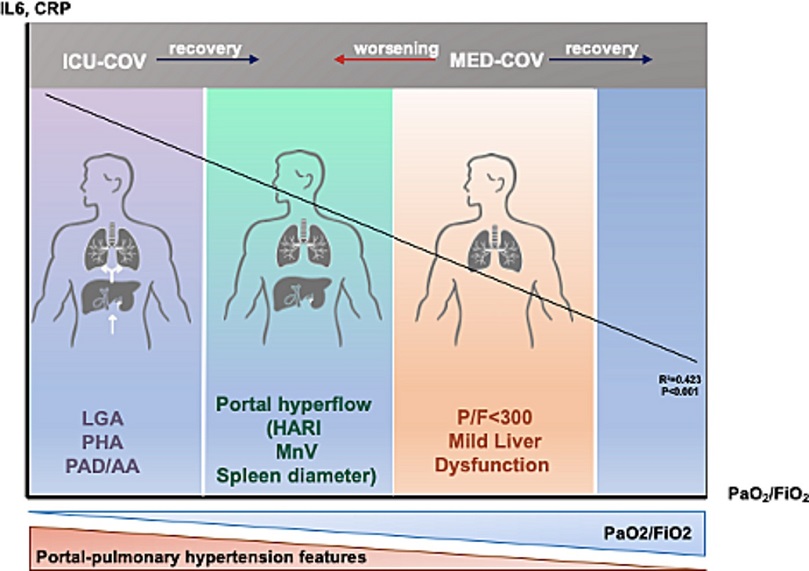Patients Affected By COVID-19 ARDS Found To Display A Portal Hyperlfow-Like Syndrome!
Nikhil Prasad Fact checked by:Thailand Medical News Team Mar 12, 2024 1 year, 1 month, 2 weeks, 5 hours, 21 minutes ago
COVID-19 News: The global impact of the coronavirus disease 2019 (COVID-19) has unraveled a myriad of clinical manifestations, with acute respiratory distress syndrome (ARDS) being a predominant feature. However, as our understanding of the disease evolves, it becomes apparent that COVID-19 is not confined to the respiratory system alone. This
COVID-19 News report delves into a groundbreaking study conducted by researchers from Fondazione IRCCS Ca’ Granda-Italy, Università degli Studi of Milan-Italy, Ospedale Maggiore Policlinico-Italy, Università Cattolica del Sacro Cuore-Italy, and Università degli Studi of Milan-Italy, revealing a portal hypertension-like syndrome observed in COVID-19 ARDS patients.
 Patients Affected By COVID-19 ARDS Found To Display A Portal Hyperlfow-Like Syndrome
Exploring Multiorgan Involvement in COVID-19
Patients Affected By COVID-19 ARDS Found To Display A Portal Hyperlfow-Like Syndrome
Exploring Multiorgan Involvement in COVID-19
The study recognizes COVID-19 as a systemic disease that extends its impact beyond the thoracic region, affecting abdominal organs as well. The research aims to investigate the circulation in the thoracoabdominal region and assess the damage incurred by abdominal organs in patients with COVID-19.
Methodology
The researchers conducted a monocentric observational study, evaluating thoracoabdominal circulation in COVID-19 patients with ARDS (n = 31) and those with mild pneumonia (n = 60). The assessment involved the use of Doppler-ultrasound and computed tomography, comparing these findings with non-COVID-19 patients experiencing ARDS (n = 10) or portal hypertension (n = 10). The results shed light on a portal hyperflow-like pattern observed in COVID-19 ARDS patients.
Results and Clinical Relevance
The study revealed that COVID-19 ARDS patients exhibited hyperdynamic visceral flow, heightened portal velocity, increased hepatic artery resistance index, and enlarged spleen diameter compared to those with mild pneumonia. The correlation between these visceral circulatory parameters and respiratory indexes, as well as pulmonary artery diameter, hinted at a connection between visceral vascular remodeling, pulmonary hypertension, and organ damage.
Furthermore, the researchers discovered a resemblance in chest and abdominal vascular remodeling patterns between COVID-19 ARDS patients and individuals with portal hypertension. A more severe presentation of COVID-19 was linked to exacerbated liver dysfunction and increased inflammatory activation, both of which correlated with abdominal and chest imaging measures.
Clinical Implications
The findings of this study hold significant clinical relevance, suggesting a direct relationship between the severity of COVID-19 lung involvement and the development of a portal hyperflow-like syndrome. Understanding this correlation may aid in the formulation of more targeted monitoring strategies and the development of specialized therapeutic interventions.
COVID-19 as a Multiorgan Disorder<
;br />
The study aligns with the evolving perspective of COVID-19 as a multiorgan disorder with distinctive features attributed to endothelial dysfunction. The severity of the disease appears linked to endothelial activation and thrombosis, resulting in hypercoagulability, microthrombosis, and angiogenesis in the lungs. The study underscores the need to explore the interplay between abdominal and thoracic damage, shedding light on potential implications of a portal hyperflow-like syndrome in exacerbating respiratory failure.
Abdominal Involvement in COVID-19
Concurrent with respiratory symptoms, COVID-19 has been shown to affect abdominal organs, with liver dysfunction being a prevalent disorder. The study notes a higher prevalence of liver dysfunction in intensive care unit (ICU) COVID-19 patients, raising questions about the etiology of this disorder. The potential involvement of portal hypertension and visceral hyperdynamic flow, often associated with abnormal coagulation and microcirculatory deregulation, draws parallels with other pathological conditions.
Hyperdynamic Circulation and Thoracoabdominal Remodeling
The study explores the hypothesis that COVID-19 induces a hyperdynamic circulatory state akin to portal hypertension, leading to a portal hyperflow-like syndrome. This sustained hyperdynamic state, combined with low hepatic resistances, may result in high portal vein velocity and subsequent liver damage. The correlation between abdominal circulation alterations, liver dysfunction, and respiratory failure represents a novel observation, bridging the gap between thoracic and abdominal involvement.
Implications for Patient Care
The research emphasizes the need for a holistic approach in managing critically ill COVID-19 patients. The observed systemic flow remodeling and portal hyperflow-like syndrome may contribute to the peculiar characteristics of respiratory failure in these patients. Recognizing this unique pattern of progressive systemic involvement could inform therapeutic strategies, focusing on the modulation of COVID-19-induced hyperdynamic circulation.
Pathophysiological Insights
The study proposes disruptions in the renin–angiotensin system homeostasis and vascular inflammation as potential pathophysiological mechanisms underlying the observed systemic hemodynamic alterations in COVID-19 patients. The infection's impact on the angiotensin converting enzyme 2 (ACE2) receptor, expressed in various organs including vascular endothelial cells, is highlighted. The resultant endothelial activation, cytokine release, and oxidative stress contribute to microvascular inflammation, dysregulated angiogenesis, and abnormal vascular tone regulation.
Conclusion
In conclusion, this comprehensive study unravels the intricate interplay between respiratory and abdominal involvement in COVID-19 patients. The identification of a portal hypertension-like syndrome in ARDS patients adds a new dimension to our understanding of the disease. The correlation between visceral vascular remodeling, pulmonary hypertension, and organ damage underscores the complexity of COVID-19 as a multiorgan disorder. These findings not only contribute to our knowledge of the disease but also pave the way for targeted therapeutic strategies and closer monitoring of critically ill patients. As the world continues to grapple with the challenges posed by COVID-19, ongoing research remains crucial in unraveling the intricacies of this formidable viral adversary.
The study findings were published in the peer reviewed Journal of Critical Care.
https://www.sciencedirect.com/science/article/pii/S0883944124002466
For the latest
COVID-19 News, keep on logging to Thailand Medical News.
